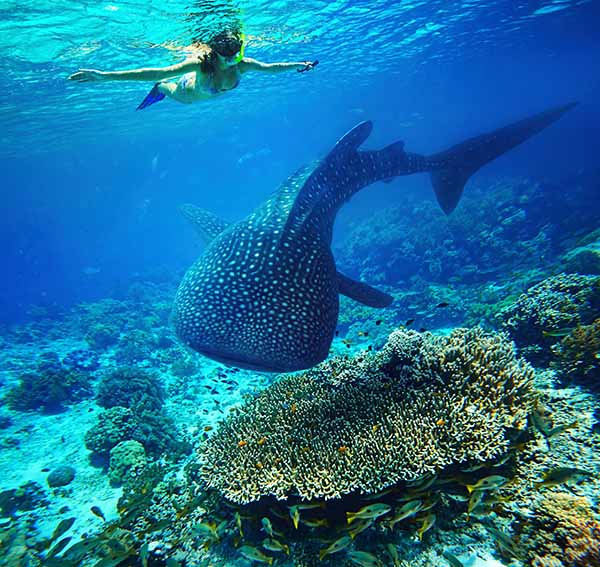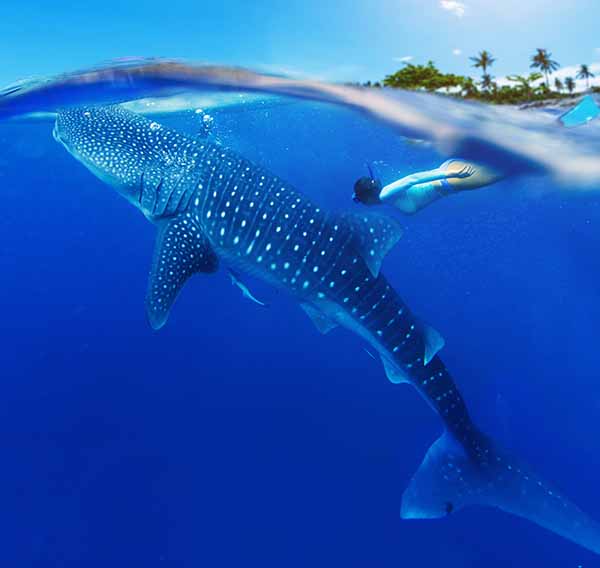
Smaller Whale Shark ventures over a shallow reef in the Philippines. Softlight/Shutterstock.
WHERE HAVE THE LARGEST WHALE SHARKS GONE?
Researchers from The University of Western Australia and the Australian Institute of Marine Science (AIMS) have raised concerns about the whereabouts of the world’s biggest Whale Sharks after finding that the largest sharks observed in recent years were smaller than those recorded more than a decade ago. The diminishing size of the nomadic giants has been noted at Ningaloo Reef, in Ningaloo Marine Park, is a pristine 260-km fringing reef off the mid-north coast of Western Australia.
The Whale Shark (Rhincodon typus) is the largest known living fish species, with the largest confirmed specimen measuring 12.65 m (41.5 ft) in length and a weight of about 21.5 t (47,000 lb). Anecdotally, larger Whale Sharks have been reported. They roam the globe’s warm seas, behemoth gentle filter feeders whose life history is far from fully understood by biologists.

Dr. Ana Sequiera of the University of Western Australia: Discovered shrinking sizes of Whale Sharks being measured.
Lead author of a new study from UWAs Oceans Institute, Dr. Ana Sequeira, said it was important to know the size of whale sharks because it provided information about their population status. She said getting accurate estimates of the size of the fish is difficult as it needs to be done while they are freely swimming. A common technique is to compare the sharks with an object of known size while swimming alongside them. However, these estimates are often inaccurate, said Dr. Sequeira.
“We found the margin for error increased as the actual size of the target increased, which meant that big sharks of around 10 to 11 metres were mistakenly thought to be up to about three metres smaller. In our study, UWA and AIMS researchers compared visual estimates of whale shark sizes with those obtained using an underwater stereo-video system.”
Dr. Sequeira said the research showed the largest sharks observed at Ningaloo Reef in recent years were smaller than those recorded at the same location more than a decade ago. The majority of whale sharks seen at Ningaloo were juveniles with mean lengths of around six metres, which given the fact that the fish reach maturity when they are about nine metres long, prompts the question: Where are the big adults?
Study co-author Dr. Mark Meekan from AIMS said that with the exception of groups of large females reported at two locations in the eastern Pacific Ocean, there has been a recent a lack of adult whale shark sightings around the world. Co-occurrence of adult males and females ensures the survival of a species. so not knowing the whereabouts of adult whale sharks and how many still exist presents a challenge for understanding their conservation status, Dr Meekan said.

The world’s largest fish and easily the biggest living non-mammalian vertebrate, eclipsed only by certain whales. Image: Max Topchii/Shutterstock.
He said one possible way to improve understanding of the whereabouts of the biggest sharks was by using satellite tagging to track the few large ones known to still occur at Ningaloo Reef but that more research is needed to help locate large whale sharks and to clarify numbers of mature animals still in existence.
“Understanding the whereabouts of the biggest whale sharks will also help us understand how human activity such as industrial developments, fisheries and boat strike, might impact the animals,” Dr Meekan said.
Adapted from materials released by
The University of Western Australia (UWA): www.uwa.edu.au
Thursday, 23 March 2016
The research, published in the journal Royal Society Open Science, was supported through the Indian Ocean Marine Research Centre (IOMRC) collaboration.





Hey I am really interested in these amazing animals and also manta ray in my spare time I continue to research about them I have dived with theses wonderful creature but I don’t think I would be accepted to any of university’s due to my school work being so poor but I have an extreme interest in marine science/ biology I don’t just research about animal I continue to research about coral and how they are into the bleaching stage of there life
can you please answer me back about what I can do thank you very much